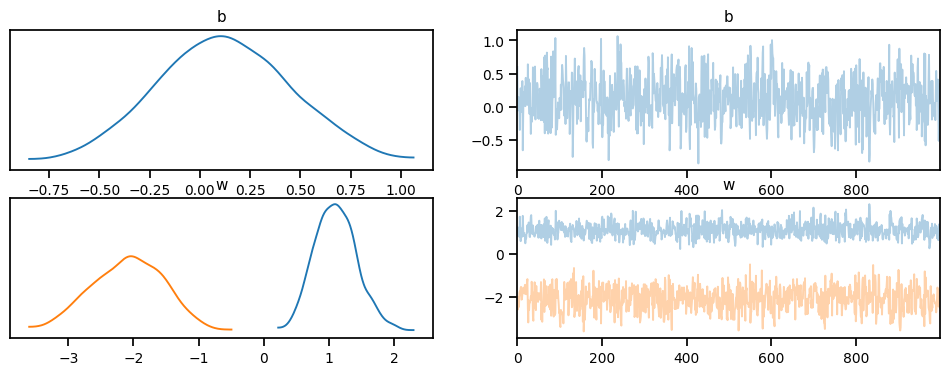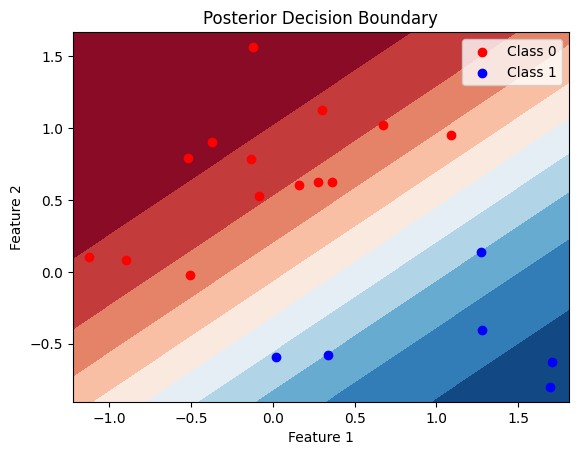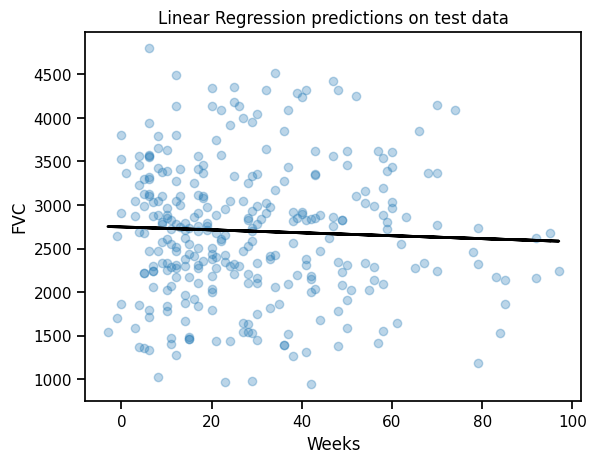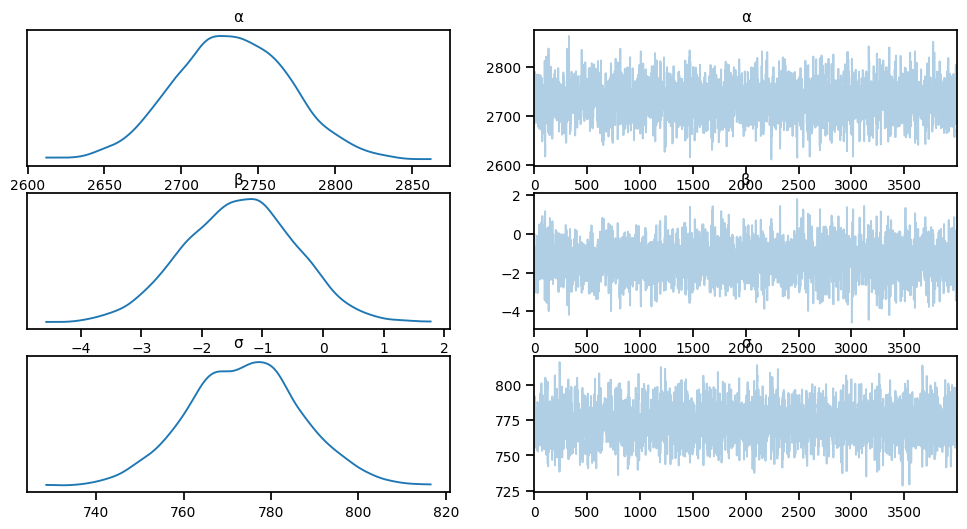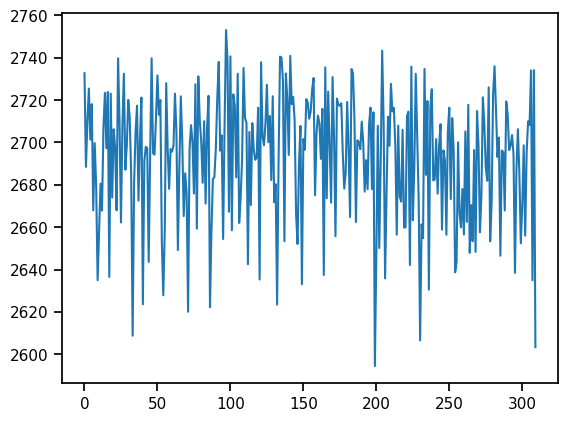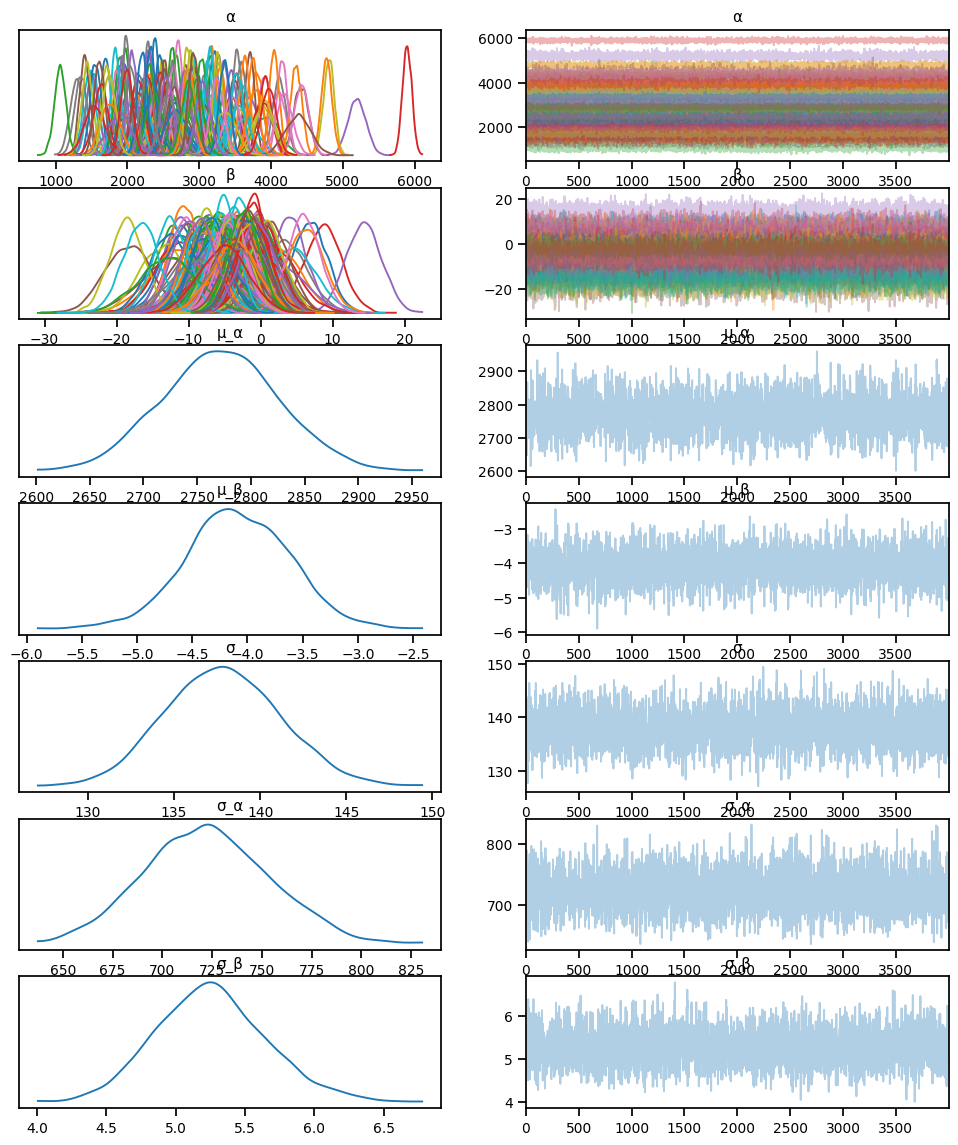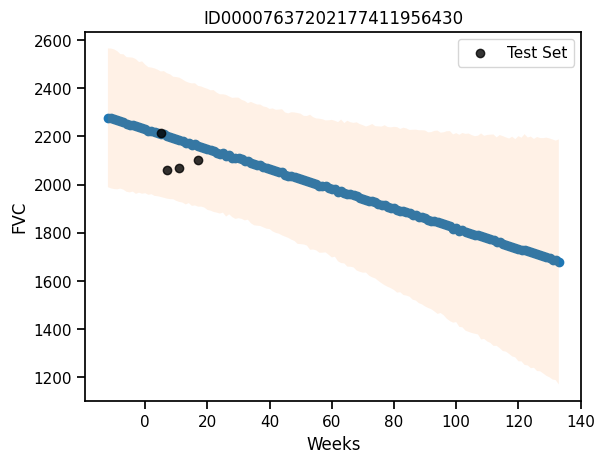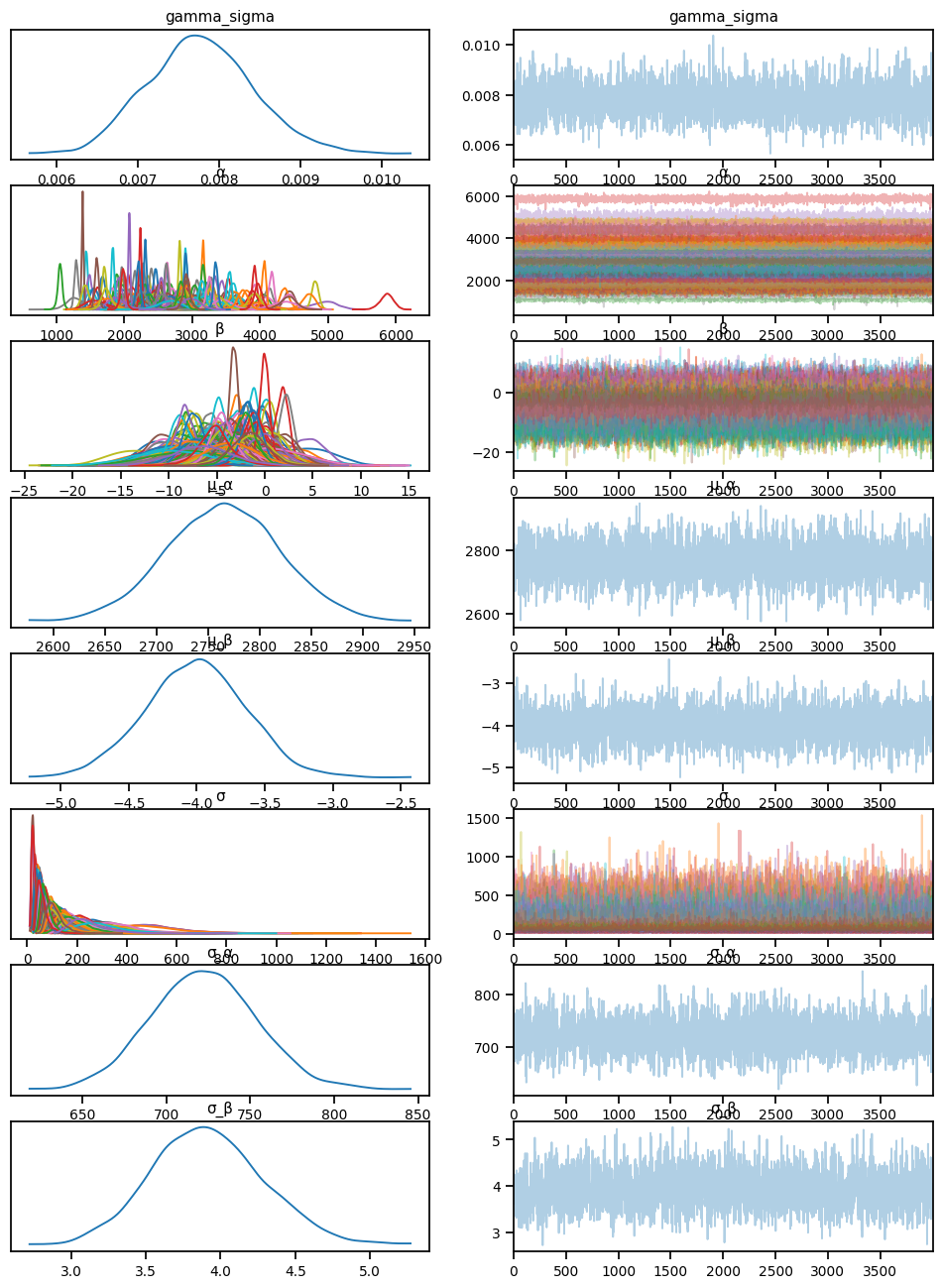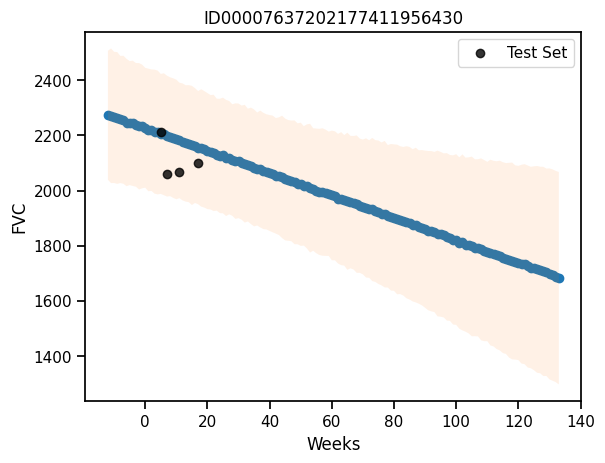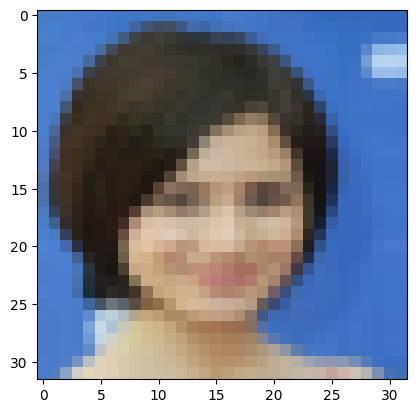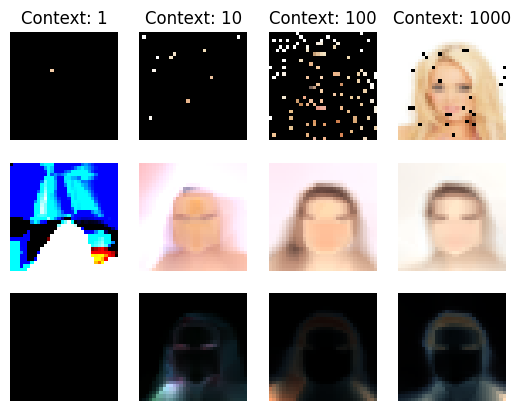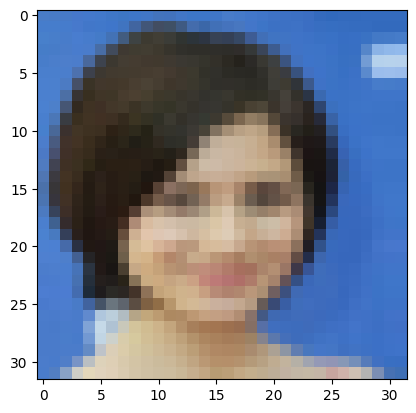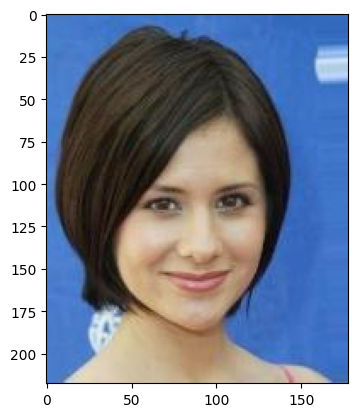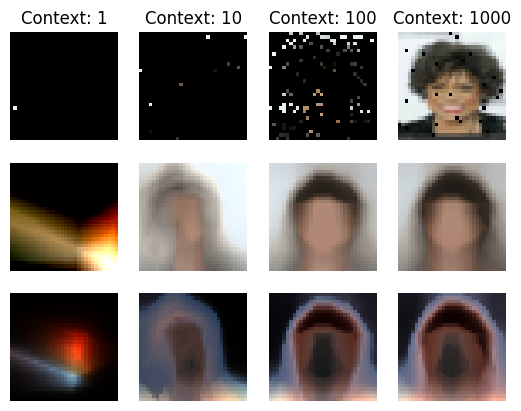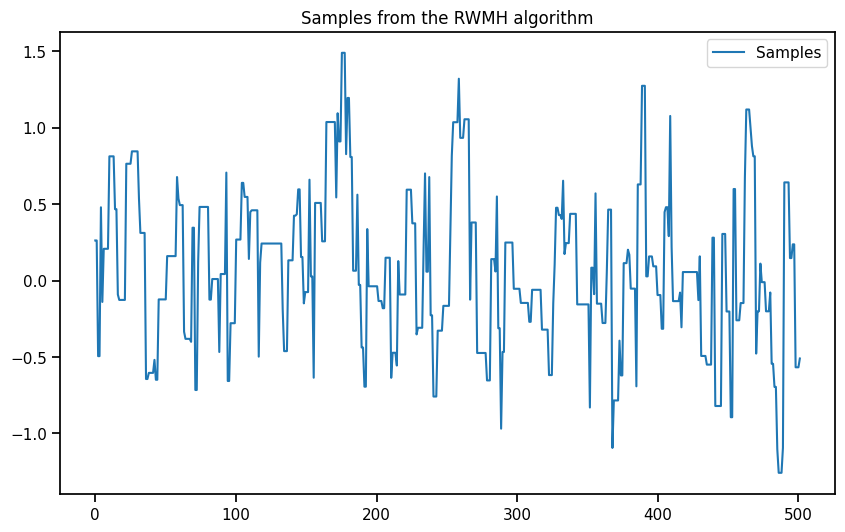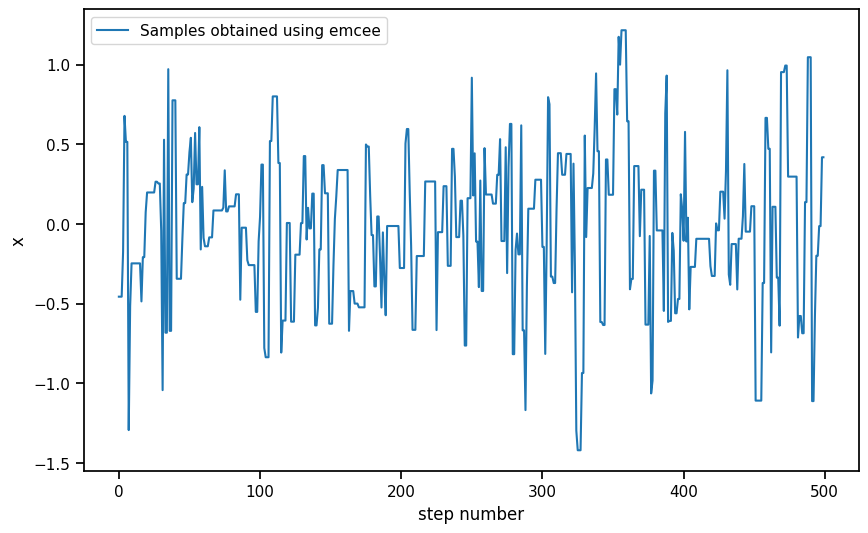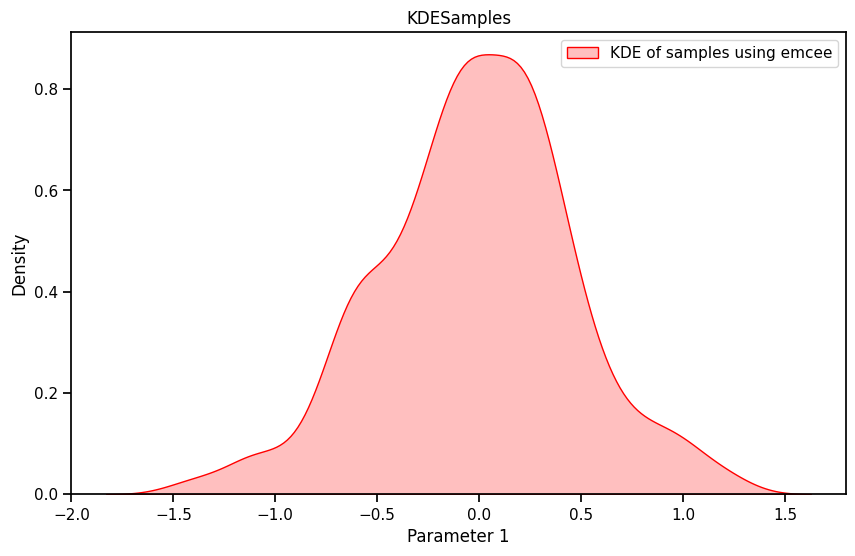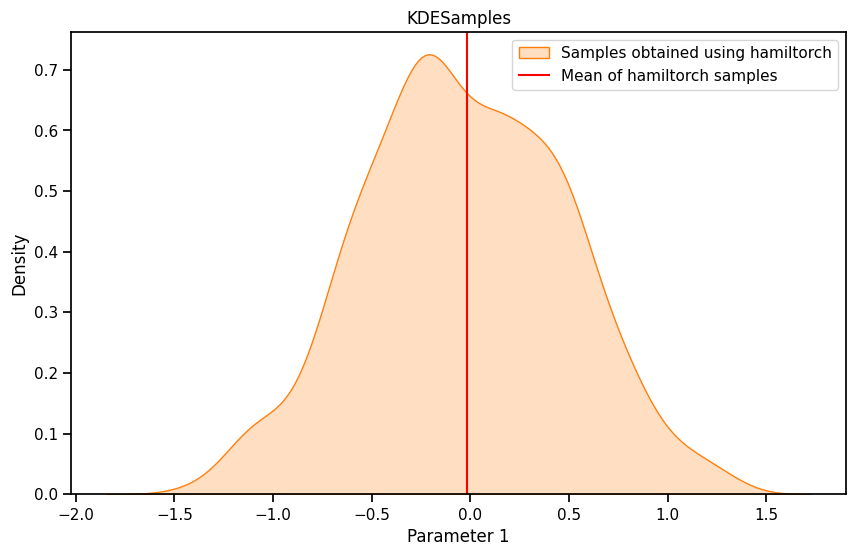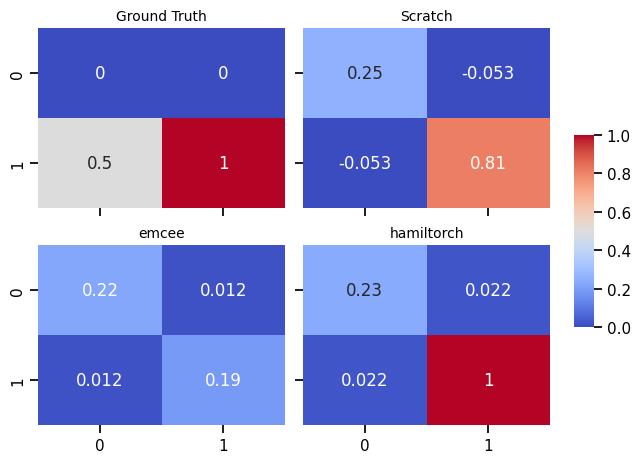import numpy as np
import matplotlib.pyplot as plt
import pandas as pd
import torch
import seaborn as sns
from jax import random
sns.set_context("notebook")Assignment 4 PML
Question 1:
Implement Logistic Regression using the Pyro library referring [1] for guidance. Show both the mean prediction as well as standard deviation in the predictions over the 2d grid. Use NUTS MCMC sampling to sample the posterior. Take 1000 samples for posterior distribution and use 500 samples as burn/warm up. Use the below given dataset.
from sklearn.datasets import make_moons
from sklearn.model_selection import train_test_split
X, y = make_moons(n_samples=100, noise=0.3, random_state=42)
X_train, X_test, y_train, y_test = train_test_split(X, y,test_size=0.2, random_state=42)try:
import numpyro
except ImportError:
%pip install numpyro
import numpyrotry:
import pyro
except ImportError:
%pip install pyro-ppl
import pyroimport pyro.distributions as distfrom pyro.infer import MCMC, NUTS, Predictivefrom sklearn.datasets import make_moons
from sklearn.model_selection import train_test_split
X, y = make_moons(n_samples=100, noise=0.3, random_state=42)
X_train, X_test, y_train, y_test = train_test_split(X, y,test_size=0.2, random_state=42)X_train = torch.tensor(X_train).float()
y_train = torch.tensor(y_train).float()
X_test = torch.tensor(X_test).float()
y_test = torch.tensor(y_test).float()
X_train.shape, y_train.shape,X_test.shape, y_test.shape(torch.Size([80, 2]), torch.Size([80]), torch.Size([20, 2]), torch.Size([20]))# Separate data points by class
class_0 = X[y == 0]
class_1 = X[y == 1]
# Create a scatter plot
plt.scatter(class_0[:, 0], class_0[:, 1], label="Class 0", marker='o')
plt.scatter(class_1[:, 0], class_1[:, 1], label="Class 1", marker='o')
plt.xlabel("Feature 1")
plt.ylabel("Feature 2")
plt.title("Generated Moons Dataset")
plt.legend()
plt.show()def logistic_model(X, y):
# sample from prior
w = pyro.sample(
'w', dist.Normal(torch.zeros(X.shape[1]), torch.ones(X.shape[1]))
)
b = pyro.sample(
'b', dist.Normal(torch.zeros(1), torch.ones(1))
)
with pyro.iarange('data', X.shape[0]):
model_logits = torch.matmul(X, w) + b
pyro.sample('obs', dist.Bernoulli(logits=model_logits), obs=y)nuts_kernel = NUTS(logistic_model, adapt_step_size=True)
mcmc = MCMC(nuts_kernel, num_samples=1000, warmup_steps=500)
mcmc.run(X_train, y_train)Warmup: 0%| | 3/1500 [00:00, 25.77it/s, step size=1.20e-01, acc. prob=0.333]Sample: 100%|██████████| 1500/1500 [00:32, 46.05it/s, step size=6.50e-01, acc. prob=0.929] posterior_samples = mcmc.get_samples()import arviz as az
idata = az.from_pyro(mcmc)
az.plot_trace(idata, compact=True);c:\Users\Dell\AppData\Local\Programs\Python\Python311\Lib\site-packages\arviz\data\io_pyro.py:157: UserWarning: Could not get vectorized trace, log_likelihood group will be omitted. Check your model vectorization or set log_likelihood=False
warnings.warn(posterior_samples['w'].mean(0), posterior_samples['b'].mean(0)(tensor([ 1.1069, -2.0874]), tensor([0.1179]))posterior_samples['w'].std(0), posterior_samples['b'].std(0)(tensor([0.3259, 0.5515]), tensor([0.3369]))# Define a function to plot the decision boundary
def plot_decision_boundary(X, y, posterior_samples, title="Posterior Decision Boundary"):
# Create a meshgrid of points for the entire feature space
x_min, x_max = X[:, 0].min() - 0.1, X[:, 0].max() + 0.1
y_min, y_max = X[:, 1].min() - 0.1, X[:, 1].max() + 0.1
xx, yy = torch.meshgrid(torch.linspace(x_min, x_max, 100), torch.linspace(y_min, y_max, 100))
# Flatten the meshgrid for prediction
grid = torch.cat((xx.reshape(-1, 1), yy.reshape(-1, 1)), dim=1)
# Get the number of posterior samples
num_samples = len(posterior_samples['w'])
# Plot the posterior decision boundary for each sample
for i in range(num_samples):
w = posterior_samples['w'][i]
b = posterior_samples['b'][i]
# Calculate the logits and probabilities
logits = torch.matmul(grid, w) + b
probs = 1 / (1 + torch.exp(-logits))
probs = probs.detach().numpy().reshape(xx.shape)
# Plot the decision boundary
# plt.contourf(xx, yy, probs, levels=[0, 0.5, 1], alpha=0.2, cmap=plt.cm.RdBu)
plt.contourf(xx, yy, probs, 10, cmap=plt.cm.RdBu)
# Plot the data points
plt.scatter(X[y == 0][:, 0], X[y == 0][:, 1], label="Class 0", marker='o', color = 'r')
plt.scatter(X[y == 1][:, 0], X[y == 1][:, 1], label="Class 1", marker='o', color = 'b')
plt.xlabel("Feature 1")
plt.ylabel("Feature 2")
plt.title(title)
plt.legend()
plt.show()
# Plot the decision boundary on the test data
plot_decision_boundary(X_test, y_test, posterior_samples)Question 2:
Consider the FVC dataset example discussed in the class. Find the notebook link at [2]. We had only used the train dataset. Now, we want to find out the performance of various models on the test dataset. Use the given dataset and deduce which model works best in terms of error (MAE) and coverage? The base model is Linear Regression by Sklearn (from sklearn.linear_model import LinearRegression). Plot the trace diagrams and posterior distribution. Also plot the predictive posterior distribution with 90% confidence interval.
URL = "https://gist.githubusercontent.com/ucals/" + "2cf9d101992cb1b78c2cdd6e3bac6a4b/raw/"+ "43034c39052dcf97d4b894d2ec1bc3f90f3623d9/"+ "osic_pulmonary_fibrosis.csv"df = pd.read_csv(URL)
df.head()| Patient | Weeks | FVC | Percent | Age | Sex | SmokingStatus | |
|---|---|---|---|---|---|---|---|
| 0 | ID00007637202177411956430 | -4 | 2315 | 58.253649 | 79 | Male | Ex-smoker |
| 1 | ID00007637202177411956430 | 5 | 2214 | 55.712129 | 79 | Male | Ex-smoker |
| 2 | ID00007637202177411956430 | 7 | 2061 | 51.862104 | 79 | Male | Ex-smoker |
| 3 | ID00007637202177411956430 | 9 | 2144 | 53.950679 | 79 | Male | Ex-smoker |
| 4 | ID00007637202177411956430 | 11 | 2069 | 52.063412 | 79 | Male | Ex-smoker |
from sklearn.model_selection import train_test_split
x_train, x_test, y_train, y_test = train_test_split(df["Weeks"], df['FVC'], train_size = 0.8, random_state = 0)
print(f"Training set shape: {x_train.shape}")
print(f"Testing set shape: {x_test.shape}")Training set shape: (1239,)
Testing set shape: (310,)### Linear regression from scikit-learn
from sklearn.linear_model import LinearRegression
lr = LinearRegression()
lr.fit(x_train.values.reshape(-1,1), y_train)LinearRegression()In a Jupyter environment, please rerun this cell to show the HTML representation or trust the notebook.
On GitHub, the HTML representation is unable to render, please try loading this page with nbviewer.org.
LinearRegression()
all_weeks = np.arange(-12, 134, 1)# Plot the data and the regression line
plt.scatter(x_test.values.reshape(-1,1), y_test, alpha=0.3)
plt.plot(x_test, lr.predict(x_test.values.reshape(-1,1)), color="black", lw=2)
plt.xlabel("Weeks")
plt.ylabel("FVC")
plt.title("Linear Regression predictions on test data")Text(0.5, 1.0, 'Linear Regression predictions on test data')Prediction: Vanilla LR
predictions = lr.predict(x_test.values.reshape(-1, 1))
from sklearn.metrics import mean_absolute_error
maes = {}
maes["LinearRegression"] = mean_absolute_error(y_test.values, predictions)
maes{'LinearRegression': 626.3184730275215}Pooled model
\(\alpha \sim \text{Normal}(0, 500)\)
\(\beta \sim \text{Normal}(0, 500)\)
\(\sigma \sim \text{HalfNormal}(100)\)
for i in range(N_Weeks):
\(FVC_i \sim \text{Normal}(\alpha + \beta \cdot Week_i, \sigma)\)
def pooled_model(X, y=None):
α = numpyro.sample("α", dist.Normal(0., 500.))
β = numpyro.sample("β", dist.Normal(0., 500.))
σ = numpyro.sample("σ", dist.HalfNormal(50.))
with numpyro.plate("samples", len(X)):
fvc = numpyro.sample("fvc", dist.Normal(α + β * X, σ), obs=y)
return fvcimport numpyro.distributions as distfrom sklearn.preprocessing import LabelEncoder
patient_encoder = LabelEncoder()
df["patient_code"] = patient_encoder.fit_transform(df["Patient"].values)sample_patient_code_train = df["patient_code"].values[x_train.index]
sample_patient_code_test = df["patient_code"].values[x_test.index]from numpyro.infer import MCMC, NUTS, Predictive
nuts_kernel = NUTS(pooled_model)
mcmc = MCMC(nuts_kernel, num_samples=4000, num_warmup=2000)
rng_key = random.PRNGKey(0)No GPU/TPU found, falling back to CPU. (Set TF_CPP_MIN_LOG_LEVEL=0 and rerun for more info.)x_train.values.reshape(-1,1).shape, y_train.values.shape((1239, 1), (1239,))mcmc.run(rng_key, X=x_train.values, y=y_train.values)
posterior_samples = mcmc.get_samples()sample: 100%|██████████| 6000/6000 [00:07<00:00, 780.32it/s, 15 steps of size 4.41e-01. acc. prob=0.93] import arviz as az
idata = az.from_numpyro(mcmc)
az.plot_trace(idata, compact=True)array([[<Axes: title={'center': 'α'}>, <Axes: title={'center': 'α'}>],
[<Axes: title={'center': 'β'}>, <Axes: title={'center': 'β'}>],
[<Axes: title={'center': 'σ'}>, <Axes: title={'center': 'σ'}>]],
dtype=object)# Summary statistics
az.summary(idata, round_to=2)arviz - WARNING - Shape validation failed: input_shape: (1, 4000), minimum_shape: (chains=2, draws=4)| mean | sd | hdi_3% | hdi_97% | mcse_mean | mcse_sd | ess_bulk | ess_tail | r_hat | |
|---|---|---|---|---|---|---|---|---|---|
| α | 2732.55 | 36.72 | 2666.72 | 2804.27 | 0.86 | 0.61 | 1831.78 | 2063.36 | NaN |
| β | -1.37 | 0.92 | -3.15 | 0.25 | 0.02 | 0.02 | 1918.32 | 2020.37 | NaN |
| σ | 773.88 | 12.85 | 749.97 | 798.30 | 0.25 | 0.18 | 2569.03 | 1991.23 | NaN |
# Predictive distribution
predictive = Predictive(pooled_model, mcmc.get_samples())predictions = predictive(rng_key, x_test.values, None)# Get the mean and standard deviation of the predictions
mu = predictions["fvc"].mean(axis=0)
sigma = predictions["fvc"].std(axis=0)
# Plot the predictions
plt.plot(x_test, mu)
plt.fill_between(x_test, mu - 1.64*sigma, mu + 1.64*sigma, alpha=0.2)
plt.scatter(x_test, y_test, alpha=0.2)
plt.xlabel("Weeks")
plt.ylabel("FVC")Text(0, 0.5, 'FVC')preds_pooled = predictive(rng_key, x_test.values, None)['fvc']
predictions_train_pooled = preds_pooled.mean(axis=0)
std_train_pooled = preds_pooled.std(axis=0)### Computing Mean Absolute Error and Coverage at 95% confidence interval
maes["PooledModel"] = mean_absolute_error(y_test, predictions_train_pooled)
maes{'LinearRegression': 626.3184730275215, 'PooledModel': 626.4611966040827}### Computing the coverage at 95% confidence interval
def coverage(y_true, y_pred, sigma):
lower = y_pred - 1.96 * sigma
upper = y_pred + 1.96 * sigma
return np.mean((y_true >= lower) & (y_true <= upper))
coverages = {}
coverages["pooled"] = coverage(y_test, predictions_train_pooled, std_train_pooled).item()
coverages{'pooled': 0.9483870967741935}Hierarchical model
\(\sigma \sim \text{HalfNormal}(100)\)
\(\mu_{\alpha} \sim \text{Normal}(0, 500)\)
\(\sigma_{\alpha} \sim \text{HalfNormal}(100)\)
\(\mu_{\beta} \sim \text{Normal}(0, 500)\)
\(\sigma_{\beta} \sim \text{HalfNormal}(100)\)
for p in range(N_patients):
\(\alpha_p \sim \text{Normal}(\mu_{\alpha}, \sigma_{\alpha})\)
\(\beta_p \sim \text{Normal}(\mu_{\beta}, \sigma_{\beta})\)
for i in range(N_Weeks):
\(FVC_i \sim \text{Normal}(\alpha_{p[i]} + \beta_{p[i]} \cdot Week_i, \sigma)\)
### Hierarchical model
def partial_pool_same_sigma(sample_weeks, sample_patient_code, sample_fvc=None):
μ_α = numpyro.sample("μ_α", dist.Normal(0.0, 500.0))
σ_α = numpyro.sample("σ_α", dist.HalfNormal(100.0))
μ_β = numpyro.sample("μ_β", dist.Normal(0.0, 3.0))
σ_β = numpyro.sample("σ_β", dist.HalfNormal(3.0))
n_patients = len(np.unique(sample_patient_code))
with numpyro.plate("Participants", n_patients):
α = numpyro.sample("α", dist.Normal(μ_α, σ_α))
β = numpyro.sample("β", dist.Normal(μ_β, σ_β))
σ = numpyro.sample("σ", dist.HalfNormal(100.0))
FVC_est = α[sample_patient_code] + β[sample_patient_code] * sample_weeks
with numpyro.plate("data", len(sample_patient_code)):
numpyro.sample("fvc", dist.Normal(FVC_est, σ), obs=sample_fvc)nuts_ppss = NUTS(partial_pool_same_sigma)
mcmc_ppss = MCMC(nuts_ppss, num_samples=4000, num_warmup=2000)
rng_key = random.PRNGKey(0)model_kwargs = {"sample_weeks": x_train.values,
"sample_patient_code": sample_patient_code_train,
"sample_fvc":y_train.values}mcmc_ppss.run(rng_key, **model_kwargs)sample: 100%|██████████| 6000/6000 [01:28<00:00, 67.52it/s, 63 steps of size 1.26e-02. acc. prob=0.85] predictive_ppss = Predictive(partial_pool_same_sigma, mcmc_ppss.get_samples())az.plot_trace(az.from_numpyro(mcmc_ppss), compact=True)array([[<Axes: title={'center': 'α'}>, <Axes: title={'center': 'α'}>],
[<Axes: title={'center': 'β'}>, <Axes: title={'center': 'β'}>],
[<Axes: title={'center': 'μ_α'}>, <Axes: title={'center': 'μ_α'}>],
[<Axes: title={'center': 'μ_β'}>, <Axes: title={'center': 'μ_β'}>],
[<Axes: title={'center': 'σ'}>, <Axes: title={'center': 'σ'}>],
[<Axes: title={'center': 'σ_α'}>, <Axes: title={'center': 'σ_α'}>],
[<Axes: title={'center': 'σ_β'}>, <Axes: title={'center': 'σ_β'}>]],
dtype=object)predictive_ppss = Predictive(partial_pool_same_sigma, mcmc_ppss.get_samples())predictions_test_ppss = predictive_ppss(rng_key,
sample_weeks = x_test.values,
sample_patient_code = sample_patient_code_test)['fvc']
mu_predictions_test_h = predictions_test_ppss.mean(axis=0)
std_predictions_test_h = predictions_test_ppss.std(axis=0)
maes["PatrialPooled_samesigma"] = mean_absolute_error(y_test, mu_predictions_test_h)
coverages["PatrialPooled_samesigma"] = coverage(y_test, mu_predictions_test_h, std_predictions_test_h).item()
print(maes)
print(coverages){'LinearRegression': 626.3184730275215, 'PooledModel': 626.4611966040827, 'PatrialPooled_samesigma': 110.46457322643649}
{'pooled': 0.9483870967741935, 'PatrialPooled_samesigma': 0.9419354838709677}# Predict for a given patient
def predict_ppss(patient_code):
predictions = predictive_ppss(rng_key, all_weeks, patient_code)
mu = predictions["fvc"].mean(axis=0)
sigma = predictions["fvc"].std(axis=0)
return mu, sigma
# Plot the predictions for a given patient
def plot_patient_ppss(patient_code):
mu, sigma = predict_ppss(patient_code)
plt.scatter(all_weeks, mu)
plt.fill_between(all_weeks, mu - 1.64*sigma, mu + 1.64*sigma, alpha=0.1)
id_to_patient = patient_encoder.inverse_transform([patient_code])[0]
patient_weeks = x_test.values[sample_patient_code_test == patient_code]
patient_fvc = y_test.values[sample_patient_code_test == patient_code]
plt.scatter(patient_weeks, patient_fvc, alpha=0.8, label="Test Set", color="black")
plt.xlabel("Weeks")
plt.ylabel("FVC")
plt.legend()
plt.title(patient_encoder.inverse_transform([patient_code])[0])
def plot_total_ppss(patient_id = 0, plot_pooled = False):
print(all_weeks.shape)
print(mu.shape)
plot_patient_ppss(np.array([patient_id]))
print(all_weeks.shape)
print(mu.shape)
if plot_pooled:
plt.plot(all_weeks, mu, color='g')
plt.fill_between(all_weeks, mu - 1.64*sigma, mu + 1.64*sigma, alpha=0.05, color='g')# plot for a given patient
plot_patient_ppss(np.array([0]))c:\Users\Dell\AppData\Local\Programs\Python\Python311\Lib\site-packages\sklearn\preprocessing\_label.py:155: DataConversionWarning: A column-vector y was passed when a 1d array was expected. Please change the shape of y to (n_samples, ), for example using ravel().
y = column_or_1d(y, warn=True)
c:\Users\Dell\AppData\Local\Programs\Python\Python311\Lib\site-packages\sklearn\preprocessing\_label.py:155: DataConversionWarning: A column-vector y was passed when a 1d array was expected. Please change the shape of y to (n_samples, ), for example using ravel().
y = column_or_1d(y, warn=True)predictions_test_ppss = predictive_ppss(rng_key,
x_test.values,
sample_patient_code_test)['fvc']
predictions_test_ppss.shape(4000, 310)mu_predictions_test_ppss = predictions_test_ppss.mean(axis=0)
std_predictions_test_ppss = predictions_test_ppss.std(axis=0)
maes["PartialPooled_samesigma"] = mean_absolute_error(y_test, mu_predictions_test_ppss)
maes{'LinearRegression': 626.3184730275215,
'PooledModel': 626.4611966040827,
'PatrialPooled_samesigma': 110.46457322643649,
'PartiallyPooled_samesigma': 110.46457322643649,
'PatrialPooled_hypersigma': 111.37391593686996,
'PartialPooled_samesigma': 110.46457322643649}Hierarchical model
\(\gamma_{\sigma} \sim \text{HalfNormal}(30)\)
\(\mu_{\alpha} \sim \text{Normal}(0, 500)\)
\(\sigma_{\alpha} \sim \text{HalfNormal}(100)\)
\(\mu_{\beta} \sim \text{Normal}(0, 500)\)
\(\sigma_{\beta} \sim \text{HalfNormal}(100)\)
for p in range(N_patients):
\(\alpha_p \sim \text{Normal}(\mu_{\alpha}, \sigma_{\alpha})\)
\(\beta_p \sim \text{Normal}(\mu_{\beta}, \sigma_{\beta})\)
\(\sigma_p \sim \text{Exp}(\gamma_{\sigma})\)
for i in range(N_Weeks):
\(FVC_i \sim \text{Normal}(\alpha_{p[i]} + \beta_{p[i]} \cdot Week_i, \sigma_{p[i]})\)
### Hierarchical model
def partial_pool_hyper_sigma(sample_weeks, sample_patient_code, sample_fvc=None):
μ_α = numpyro.sample("μ_α", dist.Normal(0.0, 500.0))
σ_α = numpyro.sample("σ_α", dist.HalfNormal(100.0))
μ_β = numpyro.sample("μ_β", dist.Normal(0.0, 3.0))
σ_β = numpyro.sample("σ_β", dist.HalfNormal(3.0))
gamma_sigma = numpyro.sample("gamma_sigma", dist.HalfNormal(30))
n_patients = len(np.unique(sample_patient_code))
with numpyro.plate("Participants", n_patients):
α = numpyro.sample("α", dist.Normal(μ_α, σ_α))
β = numpyro.sample("β", dist.Normal(μ_β, σ_β))
σ = numpyro.sample("σ", dist.Exponential(gamma_sigma))
FVC_est = α[sample_patient_code] + β[sample_patient_code] * sample_weeks
with numpyro.plate("data", len(sample_patient_code)):
numpyro.sample("fvc", dist.Normal(FVC_est, σ[sample_patient_code]), obs=sample_fvc)nuts_pphs = NUTS(partial_pool_hyper_sigma)
mcmc_pphs = MCMC(nuts_pphs, num_samples=4000, num_warmup=2000)
rng_key = random.PRNGKey(0)y_train.shape(1239,)model_kwargs = {"sample_weeks": x_train.values,
"sample_patient_code": sample_patient_code_train,
"sample_fvc":y_train.values}mcmc_pphs.run(rng_key, **model_kwargs)sample: 100%|██████████| 6000/6000 [05:03<00:00, 19.80it/s, 511 steps of size 8.39e-03. acc. prob=0.94] predictive_pphs = Predictive(partial_pool_hyper_sigma, mcmc_pphs.get_samples())az.plot_trace(az.from_numpyro(mcmc_pphs), compact=True)array([[<Axes: title={'center': 'gamma_sigma'}>,
<Axes: title={'center': 'gamma_sigma'}>],
[<Axes: title={'center': 'α'}>, <Axes: title={'center': 'α'}>],
[<Axes: title={'center': 'β'}>, <Axes: title={'center': 'β'}>],
[<Axes: title={'center': 'μ_α'}>, <Axes: title={'center': 'μ_α'}>],
[<Axes: title={'center': 'μ_β'}>, <Axes: title={'center': 'μ_β'}>],
[<Axes: title={'center': 'σ'}>, <Axes: title={'center': 'σ'}>],
[<Axes: title={'center': 'σ_α'}>, <Axes: title={'center': 'σ_α'}>],
[<Axes: title={'center': 'σ_β'}>, <Axes: title={'center': 'σ_β'}>]],
dtype=object)predictions_test_pphs = predictive_pphs(rng_key,
sample_weeks = x_test.values,
sample_patient_code = sample_patient_code_test)['fvc']
mu_predictions_test_h = predictions_test_pphs.mean(axis=0)
std_predictions_test_h = predictions_test_pphs.std(axis=0)
maes["PatrialPooled_hypersigma"] = mean_absolute_error(y_test, mu_predictions_test_h)
coverages["PatrialPooled_hypersigma"] = coverage(y_test, mu_predictions_test_h, std_predictions_test_h).item()
print(maes)
print(coverages){'LinearRegression': 626.3184730275215, 'PooledModel': 626.4611966040827, 'PatrialPooled_samesigma': 110.46457322643649, 'PartiallyPooled_samesigma': 110.46457322643649, 'PatrialPooled_hypersigma': 111.37391593686996}
{'pooled': 0.9483870967741935, 'PatrialPooled_samesigma': 0.9419354838709677, 'PatrialPooled_hypersigma': 0.9451612903225807}# Predict for a given patient
def predict_pphs(patient_code):
predictions = predictive_pphs(rng_key, all_weeks, patient_code)
mu = predictions["fvc"].mean(axis=0)
sigma = predictions["fvc"].std(axis=0)
return mu, sigma
# Plot the predictions for a given patient
def plot_patient_pphs(patient_code):
mu, sigma = predict_pphs(patient_code)
plt.scatter(all_weeks, mu)
plt.fill_between(all_weeks, mu - 1.64*sigma, mu + 1.64*sigma, alpha=0.1)
id_to_patient = patient_encoder.inverse_transform([patient_code])[0]
#print(id_to_patient[0], patient_code)
#print(patient_code, id_to_patient)
patient_weeks = x_test.values[sample_patient_code_test == patient_code]
patient_fvc = y_test.values[sample_patient_code_test == patient_code]
# patient_weeks = train[train["Patient"] == id_to_patient]["Weeks"]
# patient_fvc = train[train["Patient"] == id_to_patient]["FVC"]
plt.scatter(patient_weeks, patient_fvc, alpha=0.8, label="Test Set", color="black")
#plt.scatter(sample_weeks[train["patient_code"] == patient_code.item()], fvc[train["patient_code"] == patient_code.item()], alpha=0.5)
plt.xlabel("Weeks")
plt.ylabel("FVC")
plt.legend()
plt.title(patient_encoder.inverse_transform([patient_code])[0])
def plot_total_pphs(patient_id = 0, plot_pooled = False):
print(all_weeks.shape)
print(mu.shape)
plot_patient_pphs(np.array([patient_id]))
print(all_weeks.shape)
print(mu.shape)
if plot_pooled:
plt.plot(all_weeks, mu, color='g')
plt.fill_between(all_weeks, mu - 1.64*sigma, mu + 1.64*sigma, alpha=0.05, color='g')# plot for a given patient
plot_patient_pphs(np.array([0]))c:\Users\Dell\AppData\Local\Programs\Python\Python311\Lib\site-packages\sklearn\preprocessing\_label.py:155: DataConversionWarning: A column-vector y was passed when a 1d array was expected. Please change the shape of y to (n_samples, ), for example using ravel().
y = column_or_1d(y, warn=True)
c:\Users\Dell\AppData\Local\Programs\Python\Python311\Lib\site-packages\sklearn\preprocessing\_label.py:155: DataConversionWarning: A column-vector y was passed when a 1d array was expected. Please change the shape of y to (n_samples, ), for example using ravel().
y = column_or_1d(y, warn=True)Question 3
Use your version of following models to reproduce figure 4 from the paper referenced at conditional neural network paper. You can also refer to the notebook in the course. - Hypernet - Neural Processes
Hyper Network
import torch
import torchvision.transforms as transforms
import torch.nn as nn
# import torch.nn.functional as F
import torch.optim as optim
import os
from torch.utils.data import Dataset, DataLoader, Subset
# import torchvision.datasets as datasets
from PIL import Image
import numpy as np
import pandas as pd
import random
import matplotlib.pyplot as plt
from sklearn import preprocessing
from tqdm import trange
import os
import shutil
from tabulate import tabulate# device = torch.device("cuda" if torch.cuda.is_available() else "cpu")
device = torch.device("cuda:3")
print(device)
current_device = device #torch.cuda.current_device()
device_name = torch.cuda.get_device_name(current_device)
print(f"Current GPU assigned: {current_device}, Name: {device_name}")cuda:3
Current GPU assigned: cuda:3, Name: NVIDIA A100-SXM4-80GBCeleba data link
Note book ref link
prepare data
# import os
# data_root = '/home/jaiswalsuraj/suraj_work/projects/data/celeba/img_align_celeba'
# # Check if the specified directory exists
# if os.path.exists(data_root):
# # List all files in the directory with a specific image extension (e.g., .jpg)
# image_files = [f for f in os.listdir(data_root) if f.endswith('.jpg')]
# # Get the count of image files
# num_images = len(image_files)
# print(f"Number of images in '{data_root}': {num_images}")
# else:
# print(f"The directory '{data_root}' does not exist.")Number of images in '/home/jaiswalsuraj/suraj_work/projects/data/celeba/img_align_celeba': 202599# data_folder_size = 200000
# data_root = '/home/jaiswalsuraj/suraj_work/projects/data/celeba/img_align_celeba'
# output_dir = f'/home/jaiswalsuraj/suraj_work/projects/data/celeba/img_align_celeba_{data_folder_size}'
# # Check if the specified input directory exists
# if os.path.exists(data_root):
# # Ensure the output directory exists, or create it if necessary
# if not os.path.exists(output_dir):
# os.makedirs(output_dir)
# # List all files in the input directory
# all_image_files = [f for f in os.listdir(data_root) if f.endswith('.jpg')]
# # random_images = random.sample(all_image_files, data_folder_size)
# images_list = all_image_files[:data_folder_size]
# # Copy the randomly selected images to the output directory
# for image_file in images_list:
# src_path = os.path.join(data_root, image_file)
# dst_path = os.path.join(output_dir, image_file)
# shutil.copy2(src_path, dst_path)
# print(f"Successfully copied {data_folder_size} random images to '{output_dir}'.")
# else:
# print(f"The input directory '{data_root}' does not exist.")Successfully copied 200000 random images to '/home/jaiswalsuraj/suraj_work/projects/data/celeba/img_align_celeba_200000'.test data: last 2599 images
# data_folder_size = 2599
# data_root = '/home/jaiswalsuraj/suraj_work/projects/data/celeba/img_align_celeba'
# output_dir = f'/home/jaiswalsuraj/suraj_work/projects/data/celeba/img_align_celeba_{data_folder_size}'
# # Check if the specified input directory exists
# if os.path.exists(data_root):
# # Ensure the output directory exists, or create it if necessary
# if not os.path.exists(output_dir):
# os.makedirs(output_dir)
# # List all files in the input directory
# all_image_files = [f for f in os.listdir(data_root) if f.endswith('.jpg')]
# # random_images = random.sample(all_image_files, data_folder_size)
# images_list = all_image_files[data_folder_size:]
# # Copy the randomly selected images to the output directory
# for image_file in images_list:
# src_path = os.path.join(data_root, image_file)
# dst_path = os.path.join(output_dir, image_file)
# shutil.copy2(src_path, dst_path)
# print(f"Successfully copied {data_folder_size} random images to '{output_dir}'.")
# else:
# print(f"The input directory '{data_root}' does not exist.")Successfully copied 2599 random images to '/home/jaiswalsuraj/suraj_work/projects/data/celeba/img_align_celeba_2599'.Extras
class CustomImageDataset(Dataset):
def __init__(self, data_root, transform=None):
self.data_root = data_root
self.transform = transform
self.image_files = [f for f in os.listdir(data_root) if f.endswith('.jpg')]
def __len__(self):
return len(self.image_files)
def __getitem__(self, idx):
img_name = os.path.join(self.data_root, self.image_files[idx])
image = Image.open(img_name)
if self.transform:
image = self.transform(image)
return image# Create a coordinate dataset from the image
def create_coordinate_map(img):
"""
img: torch.Tensor of shape (num_channels, height, width)
return: tuple of torch.Tensor of shape (height* width, 2) and torch.tensor containing the (num_channels)
"""
num_channels, height, width = img.shape
# Create a 2D grid of (x,y) coordinates
x_coords = torch.arange(width).repeat(height, 1)
y_coords = torch.arange(height).repeat(width, 1).t()
x_coords = x_coords.reshape(-1)
y_coords = y_coords.reshape(-1)
# Combine the x and y coordinates into a single tensor
X = torch.stack([x_coords, y_coords], dim=1).float()
# Move X to GPU if available
X = X.to(device)
# Create a tensor containing the image pixel values
Y = img.reshape(-1, num_channels).float().to(device)
return X, Ydef neg_loglikelyhood(y_pred,log_sigma,y_true):
cov_matrix = torch.diag_embed(log_sigma.exp())
dist = torch.distributions.MultivariateNormal(y_pred,cov_matrix,validate_args=False)
return - dist.log_prob(y_true).sum()def count_params(model):
# return torch.sum(p.numel() for p in model.parameters() if p.requires_grad)
return torch.sum(torch.tensor([p.numel() for p in model.parameters()]))loading and preprocessing
batch_size = 1 # keep this to 1
img_size = 32 # Change as needed
# Specify the root directory where the dataset is located
data_root = '/home/jaiswalsuraj/suraj_work/projects/data/celeba/img_align_celeba_10000'
# Define the data transformations
transform = transforms.Compose([
transforms.Resize((img_size, img_size)), # Resize the images to a common size (adjust as needed)
transforms.ToTensor(), # Convert images to tensors
])
# default shape is torch.Size([3, 218, 178])
# Create the custom dataset
celeba_dataset = CustomImageDataset(data_root, transform=transform)
# Create a data loader
data_loader = DataLoader(celeba_dataset, batch_size=batch_size, shuffle=False)Original image after transformation
Original image
model defination
target net defination
# Create a MLP with 5 hidden layers with 256 neurons each and ReLU activations.
# Input is (x, y) and output is (r, g, b) or (g) for grayscale
# here we output 6 values (3 for RGB mean and 3 for RGB std)
s = 128 # hidden dim of model
class TargetNet(nn.Module):
def _init_siren(self, activation_scale):
self.fc1.weight.data.uniform_(-1/self.fc1.in_features, 1/self.fc1.in_features)
for layers in [self.fc2, self.fc3, self.fc4, self.fc5]:
layers.weight.data.uniform_(-np.sqrt(6/self.fc2.in_features)/activation_scale,
np.sqrt(6/self.fc2.in_features)/activation_scale)
def __init__(self, activation=torch.relu, n_out=1, activation_scale=1.0):
super().__init__()
self.activation = activation
self.activation_scale = activation_scale
self.fc1 = nn.Linear(2, s) # input size is 2 (x, y) location of pixel
self.fc2 = nn.Linear(s, s)
self.fc3 = nn.Linear(s, s)
self.fc4 = nn.Linear(s, s)
self.fc5 = nn.Linear(s, n_out) #gray scale image (1) or RGB (3)
if self.activation == torch.sin:
# init weights and biases for sine activation
self._init_siren(activation_scale=self.activation_scale)
def forward(self, x):
x = self.activation(self.activation_scale*self.fc1(x))
x = self.activation(self.activation_scale*self.fc2(x))
x = self.activation(self.activation_scale*self.fc3(x))
x = self.activation(self.activation_scale*self.fc4(x))
return self.fc5(x)Hypernetwork defination
Input: (x, y, R, G, B)
Output: Our Hypernetwork should have the output equal to the number of parameters in the main network.
# pass total params of target network before calling the hypernetwork model
class HyperNet(nn.Module):
def __init__(self, total_params, num_neurons=128, activation=torch.relu):
super().__init__()
self.activation = activation
self.n_out = total_params
self.fc1 = nn.Linear(5, num_neurons)
self.fc2 = nn.Linear(num_neurons, num_neurons)
self.fc3 = nn.Linear(num_neurons, self.n_out)
def forward(self, x):
x = self.activation(self.fc1(x))
x = self.activation(self.fc2(x))
return self.fc3(x)Initialize the model and input
Initialize the target network
from torchinfo import summary
targetnet = TargetNet(activation=torch.relu, n_out=6, activation_scale=1).to(device)
summary(targetnet, input_size=(img_size* img_size, 2)) #32*32 =1024 is the image size lentgh, 2 is x,y coordinate
# outputs 6: 1,2,3 mean of each channel and 4,5,6 are log sigma of each channel==========================================================================================
Layer (type:depth-idx) Output Shape Param #
==========================================================================================
TargetNet [1024, 6] --
├─Linear: 1-1 [1024, 128] 384
├─Linear: 1-2 [1024, 128] 16,512
├─Linear: 1-3 [1024, 128] 16,512
├─Linear: 1-4 [1024, 128] 16,512
├─Linear: 1-5 [1024, 6] 774
==========================================================================================
Total params: 50,694
Trainable params: 50,694
Non-trainable params: 0
Total mult-adds (M): 51.91
==========================================================================================
Input size (MB): 0.01
Forward/backward pass size (MB): 4.24
Params size (MB): 0.20
Estimated Total Size (MB): 4.45
==========================================================================================targetnetTargetNet(
(fc1): Linear(in_features=2, out_features=128, bias=True)
(fc2): Linear(in_features=128, out_features=128, bias=True)
(fc3): Linear(in_features=128, out_features=128, bias=True)
(fc4): Linear(in_features=128, out_features=128, bias=True)
(fc5): Linear(in_features=128, out_features=6, bias=True)
)count_params(targetnet)tensor(50694)initialize the hypernetwork model
hypernet = HyperNet(total_params=count_params(targetnet), activation=torch.sin).to(device)
print(hypernet)HyperNet(
(fc1): Linear(in_features=5, out_features=128, bias=True)
(fc2): Linear(in_features=128, out_features=128, bias=True)
(fc3): Linear(in_features=128, out_features=50694, bias=True)
)summary(hypernet,input_size=(img_size* img_size,5)) # 32*32 = 1024 is the image size length, 5 is the input(x,y,r,g,b) to hypernet==========================================================================================
Layer (type:depth-idx) Output Shape Param #
==========================================================================================
HyperNet [1024, 50694] --
├─Linear: 1-1 [1024, 128] 768
├─Linear: 1-2 [1024, 128] 16,512
├─Linear: 1-3 [1024, 50694] 6,539,526
==========================================================================================
Total params: 6,556,806
Trainable params: 6,556,806
Non-trainable params: 0
Total mult-adds (G): 6.71
==========================================================================================
Input size (MB): 0.02
Forward/backward pass size (MB): 417.38
Params size (MB): 26.23
Estimated Total Size (MB): 443.63
==========================================================================================table_data = []
total_params = 0
start = 0
start_end_mapping = {}
for name, param in targetnet.named_parameters():
param_count = torch.prod(torch.tensor(param.shape)).item()
total_params += param_count
end = total_params
table_data.append([name, param.shape, param_count, start, end])
start_end_mapping[name] = (start, end)
start = end
print(tabulate(table_data, headers=["Layer Name", "Shape", "Parameter Count", "Start Index", "End Index"]))
print(f"Total number of parameters: {total_params}")Layer Name Shape Parameter Count Start Index End Index
------------ ---------------------- ----------------- ------------- -----------
fc1.weight torch.Size([128, 2]) 256 0 256
fc1.bias torch.Size([128]) 128 256 384
fc2.weight torch.Size([128, 128]) 16384 384 16768
fc2.bias torch.Size([128]) 128 16768 16896
fc3.weight torch.Size([128, 128]) 16384 16896 33280
fc3.bias torch.Size([128]) 128 33280 33408
fc4.weight torch.Size([128, 128]) 16384 33408 49792
fc4.bias torch.Size([128]) 128 49792 49920
fc5.weight torch.Size([6, 128]) 768 49920 50688
fc5.bias torch.Size([6]) 6 50688 50694
Total number of parameters: 50694initialize the input
corr, vals = create_coordinate_map(data_loader.dataset[0])
corr, vals(tensor([[ 0., 0.],
[ 1., 0.],
[ 2., 0.],
...,
[29., 31.],
[30., 31.],
[31., 31.]], device='cuda:3'),
tensor([[0.4510, 0.4706, 0.4824],
[0.4745, 0.4745, 0.4471],
[0.4667, 0.4353, 0.5412],
...,
[0.0314, 0.0549, 0.0471],
[0.0431, 0.0392, 0.0510],
[0.0549, 0.0392, 0.0549]], device='cuda:3'))scaler_img = preprocessing.MinMaxScaler().fit(corr.cpu())
xy = torch.tensor(scaler_img.transform(corr.cpu())).float().to(device)
xy, xy.shape(tensor([[0.0000, 0.0000],
[0.0323, 0.0000],
[0.0645, 0.0000],
...,
[0.9355, 1.0000],
[0.9677, 1.0000],
[1.0000, 1.0000]], device='cuda:3'),
torch.Size([1024, 2]))Training loop
n_epochs=20
lr = 0.003
targetnet = TargetNet(activation=torch.relu, n_out=6, activation_scale=1).to(device)
hypernet = HyperNet(total_params=count_params(targetnet), activation=torch.relu).to(device)
optimizer = optim.Adam(hypernet.parameters(),lr=lr) # only hypernet is updated
n_context = 100
print("Context Points=",n_context)
for epoch in trange(n_epochs):
c_idx = np.array(random.sample(range(1023),n_context))
print("Epoch=",epoch+1)
epoch_loss = 0
i=1
for data in data_loader:
# print(data.shape)
optimizer.zero_grad()
pixel_intensity = data.reshape(3,-1).T.to(device).float()
input = torch.concatenate([xy[c_idx],pixel_intensity[c_idx]],axis=1).float()
hyper_out = hypernet(input)
hyper_out = torch.mean(hyper_out,dim=0)
target_dict ={}
for name,param in targetnet.named_parameters():
start,end = start_end_mapping[name]
target_dict[name] = hyper_out[start:end].reshape(param.shape)
img_out = torch.func.functional_call(targetnet, target_dict, xy)
# print(img_out.shape, img_out[:,:3].shape, img_out[:,3:].shape, pixel_intensity.shape)
# print( img_out[:,:3], img_out[:,3:], pixel_intensity)
loss = neg_loglikelyhood(img_out[:,:3],img_out[:,3:],pixel_intensity)
loss.backward()
optimizer.step()
epoch_loss = epoch_loss + loss.item()
i=i+1
print("Epoch Loss=",epoch_loss/len(data_loader))Context Points= 100 0%| | 0/20 [00:00<?, ?it/s]Epoch= 1 5%|▌ | 1/20 [01:05<20:42, 65.40s/it]Epoch Loss= -395.47315481672285
Epoch= 2 10%|█ | 2/20 [02:10<19:37, 65.41s/it]Epoch Loss= -915.5049703121185
Epoch= 3 15%|█▌ | 3/20 [03:15<18:29, 65.26s/it]Epoch Loss= -1166.0503022047044
Epoch= 4 20%|██ | 4/20 [04:21<17:24, 65.28s/it]Epoch Loss= -1349.56748127985
Epoch= 5 25%|██▌ | 5/20 [05:26<16:19, 65.30s/it]Epoch Loss= -1396.8538594449997
Epoch= 6 30%|███ | 6/20 [06:31<15:14, 65.31s/it]Epoch Loss= -1479.6613237543106
Epoch= 7 35%|███▌ | 7/20 [07:37<14:09, 65.36s/it]Epoch Loss= -1449.8615832103728
Epoch= 8 40%|████ | 8/20 [08:42<13:04, 65.38s/it]Epoch Loss= -1528.4998937654495
Epoch= 9 45%|████▌ | 9/20 [09:47<11:58, 65.31s/it]Epoch Loss= -1538.7266953744888
Epoch= 10 50%|█████ | 10/20 [10:53<10:53, 65.36s/it]Epoch Loss= -1574.4109719749451
Epoch= 11 55%|█████▌ | 11/20 [11:58<09:48, 65.35s/it]Epoch Loss= -1558.2231241334914
Epoch= 12 60%|██████ | 12/20 [13:03<08:42, 65.32s/it]Epoch Loss= -1585.886608516693
Epoch= 13 65%|██████▌ | 13/20 [14:09<07:36, 65.27s/it]Epoch Loss= -1586.6056880670546
Epoch= 14 70%|███████ | 14/20 [15:14<06:31, 65.23s/it]Epoch Loss= -1561.2374246302604
Epoch= 15 75%|███████▌ | 15/20 [16:19<05:25, 65.20s/it]Epoch Loss= -1606.3488553873062
Epoch= 16 80%|████████ | 16/20 [17:24<04:20, 65.24s/it]Epoch Loss= -1637.4123486403466
Epoch= 17 85%|████████▌ | 17/20 [18:30<03:15, 65.29s/it]Epoch Loss= -1656.406247360611
Epoch= 18 90%|█████████ | 18/20 [19:33<02:09, 64.69s/it]Epoch Loss= -1621.5405502536773
Epoch= 19 95%|█████████▌| 19/20 [20:38<01:04, 64.88s/it]Epoch Loss= -1708.3212175039291
Epoch= 20100%|██████████| 20/20 [21:44<00:00, 65.21s/it]Epoch Loss= -1700.857941632271saving and loading the model
torch.save(hypernet.state_dict(), 'hypernet_model_10000.pth')
torch.save(targetnet.state_dict(), 'targetnet_model_10000.pth')# Load the hypernet and targetnet models
hypernet = HyperNet(total_params=count_params(targetnet), activation=torch.relu).to(device)
hypernet.load_state_dict(torch.load('hypernet_model_10000.pth'))
hypernet.eval() # Set the model to evaluation modeHyperNet(
(fc1): Linear(in_features=5, out_features=128, bias=True)
(fc2): Linear(in_features=128, out_features=128, bias=True)
(fc3): Linear(in_features=128, out_features=50694, bias=True)
)targetnet = TargetNet(activation=torch.relu, n_out=6, activation_scale=1).to(device)
targetnet.load_state_dict(torch.load('targetnet_model_10000.pth'))
targetnet.eval()TargetNet(
(fc1): Linear(in_features=2, out_features=128, bias=True)
(fc2): Linear(in_features=128, out_features=128, bias=True)
(fc3): Linear(in_features=128, out_features=128, bias=True)
(fc4): Linear(in_features=128, out_features=128, bias=True)
(fc5): Linear(in_features=128, out_features=6, bias=True)
)Plots
loading the test data
batch_size = 1 # keep this to 1
img_size = 32 # Change as needed
# Specify the root directory where the dataset is located
data_root = '/home/jaiswalsuraj/suraj_work/projects/data/celeba/img_align_celeba_2599'
# Define the data transformations
transform = transforms.Compose([
transforms.Resize((img_size, img_size)), # Resize the images to a common size (adjust as needed)
transforms.ToTensor(), # Convert images to tensors
])
# default shape is torch.Size([3, 218, 178])
# Create the custom dataset
celeba_dataset = CustomImageDataset(data_root, transform=transform)
# Create a data loader
test_data_loader = DataLoader(celeba_dataset, batch_size=batch_size, shuffle=False)def plot_hypernet(data,hypernet,targetnet,c_idx):
pixel_intensity = data.reshape(3,-1).T.to(device).float()
input = torch.concatenate([xy[c_idx],pixel_intensity[c_idx]],axis=1).float()
hyper_out = hypernet(input) # hyper_out is a tensor of shape (n_context, total_params)
hyper_out = torch.mean(hyper_out,dim=0) # aggregate across context points
target_dict ={}
start = 0
for name,param in targetnet.named_parameters():
end = start + param.numel()
target_dict[name] = hyper_out[start:end].reshape(param.shape)
start = end
img_out = torch.func.functional_call(targetnet, target_dict, xy)
return img_out.cpu().detach()c_1 = np.array(random.sample(range(img_size*img_size),1))
c_10 = np.array(random.sample(range(img_size*img_size),10))
c_100 = np.array(random.sample(range(img_size*img_size),100))
c_1000 = np.array(random.sample(range(img_size*img_size),1000))
image_any = test_data_loader.dataset[0]
idx = 0
data = image_anyplt.figure(figsize=(9,7),constrained_layout=True)
plt.suptitle("HyperNetworks",fontsize=20)
def plot_image(i,j,k, data,hypernet,targetnet, c_idx):
plt.subplot(i,j,k)
img = data.permute(1,2,0)
mask = np.zeros((32,32,3))
mask[c_idx//32,c_idx%32,:] = 1
plt.imshow(img*mask)
plt.title(f"Context: {len(c_idx)}")
plt.axis('off')
plt.subplot(i,j,k+4)
plot_image = plot_hypernet(data,hypernet,targetnet,c_idx)
plt.imshow(plot_image[:,:3].T.reshape(3,32,32).permute(1,2,0))
plt.axis('off')
plt.subplot(i,j,k+8)
var =plot_image[:,3:].exp().T.reshape(3,32,32).permute(1,2,0)
var = var-var.min()
var = var/var.max()
plt.imshow(var)
plt.axis('off')<Figure size 900x700 with 0 Axes>data.shapetorch.Size([3, 32, 32])plot_image(3,4,1,data,hypernet,targetnet,c_1)
plot_image(3,4,2,data,hypernet,targetnet,c_10)
plot_image(3,4,3,data,hypernet,targetnet,c_100)
plot_image(3,4,4,data,hypernet,targetnet,c_1000)Clipping input data to the valid range for imshow with RGB data ([0..1] for floats or [0..255] for integers).
Clipping input data to the valid range for imshow with RGB data ([0..1] for floats or [0..255] for integers).
Clipping input data to the valid range for imshow with RGB data ([0..1] for floats or [0..255] for integers).
Clipping input data to the valid range for imshow with RGB data ([0..1] for floats or [0..255] for integers).
/home/jaiswalsuraj/miniconda3/envs/tf_gpu/lib/python3.10/site-packages/matplotlib/cm.py:478: RuntimeWarning: invalid value encountered in cast
xx = (xx * 255).astype(np.uint8)Neural Processes
Celeba data link
Note book ref link
loading and preprocessing
batch_size = 1 # keep this to 1
img_size = 32 # Change as needed
# Specify the root directory where the dataset is located
data_root = '/home/jaiswalsuraj/suraj_work/projects/data/celeba/img_align_celeba_10000'
# Define the data transformations
transform = transforms.Compose([
transforms.Resize((img_size, img_size)), # Resize the images to a common size (adjust as needed)
transforms.ToTensor(), # Convert images to tensors
])
# default shape is torch.Size([3, 218, 178])
# Create the custom dataset
celeba_dataset = CustomImageDataset(data_root, transform=transform)
# Create a data loader
data_loader = DataLoader(celeba_dataset, batch_size=batch_size, shuffle=True)Original image after transformation
Original image
plt.imshow(torch.einsum('chw -> hwc', data_loader.dataset[33]))<matplotlib.image.AxesImage at 0x7f800aac09d0>Encoder Decoder model defination
class Encoder(nn.Module):
def __init__(self, input_dim, hidden_dim, z_dim,activation=torch.sin,activation_scale=30.0):
super().__init__()
self.activation = activation
self.activation_scale = activation_scale
if activation != torch.sin:
self.activation_scale = 1.0
self.linear1 = nn.Linear(input_dim, hidden_dim)
self.linear2 = nn.Linear(hidden_dim, hidden_dim)
self.linear3 = nn.Linear(hidden_dim, z_dim)
def forward(self, x):
x = self.activation(self.linear1(x)*self.activation_scale)
x = self.activation(self.linear2(x)*self.activation_scale)
return self.linear3(x)
class Decoder(nn.Module):
def __init__(self, z_dim, hidden_dim, output_dim,activation=torch.sin,activation_scale=30.0):
super().__init__()
self.activation = activation
self.activation_scale = activation_scale
if activation != torch.sin:
self.activation_scale = 1.0
self.linear1 = nn.Linear(z_dim, hidden_dim)
self.linear2 = nn.Linear(hidden_dim, hidden_dim)
self.linear3 = nn.Linear(hidden_dim, hidden_dim)
self.linear4 = nn.Linear(hidden_dim, hidden_dim)
self.linear5 = nn.Linear(hidden_dim, output_dim)
def forward(self, x):
x = self.activation(self.linear1(x)*self.activation_scale)
x = self.activation(self.linear2(x)*self.activation_scale)
x = self.activation(self.linear3(x)*self.activation_scale)
x = self.activation(self.linear4(x)*self.activation_scale)
return self.linear5(x)from torchinfo import summary
encoder = Encoder(5, 256, 128, activation=torch.relu,activation_scale=1)
summary(encoder,input_size=(img_size*img_size,5)) # 32*32 = 1024 is the image size length, 5 is the input(x,y,r,g,b) to hypernet==========================================================================================
Layer (type:depth-idx) Output Shape Param #
==========================================================================================
Encoder [1024, 128] --
├─Linear: 1-1 [1024, 256] 1,536
├─Linear: 1-2 [1024, 256] 65,792
├─Linear: 1-3 [1024, 128] 32,896
==========================================================================================
Total params: 100,224
Trainable params: 100,224
Non-trainable params: 0
Total mult-adds (M): 102.63
==========================================================================================
Input size (MB): 0.02
Forward/backward pass size (MB): 5.24
Params size (MB): 0.40
Estimated Total Size (MB): 5.66
==========================================================================================print(encoder)Encoder(
(linear1): Linear(in_features=5, out_features=256, bias=True)
(linear2): Linear(in_features=256, out_features=256, bias=True)
(linear3): Linear(in_features=256, out_features=128, bias=True)
)decoder = Decoder(130, 256, 6, activation=torch.relu,activation_scale=1)
summary(decoder,input_size=(img_size*img_size,130))==========================================================================================
Layer (type:depth-idx) Output Shape Param #
==========================================================================================
Decoder [1024, 6] --
├─Linear: 1-1 [1024, 256] 33,536
├─Linear: 1-2 [1024, 256] 65,792
├─Linear: 1-3 [1024, 256] 65,792
├─Linear: 1-4 [1024, 256] 65,792
├─Linear: 1-5 [1024, 6] 1,542
==========================================================================================
Total params: 232,454
Trainable params: 232,454
Non-trainable params: 0
Total mult-adds (M): 238.03
==========================================================================================
Input size (MB): 0.53
Forward/backward pass size (MB): 8.44
Params size (MB): 0.93
Estimated Total Size (MB): 9.90
==========================================================================================print(decoder)Decoder(
(linear1): Linear(in_features=130, out_features=256, bias=True)
(linear2): Linear(in_features=256, out_features=256, bias=True)
(linear3): Linear(in_features=256, out_features=256, bias=True)
(linear4): Linear(in_features=256, out_features=256, bias=True)
(linear5): Linear(in_features=256, out_features=6, bias=True)
)initialize the input
corr, vals = create_coordinate_map(data_loader.dataset[0])
corr, vals(tensor([[ 0., 0.],
[ 1., 0.],
[ 2., 0.],
...,
[29., 31.],
[30., 31.],
[31., 31.]], device='cuda:2'),
tensor([[0.4510, 0.4706, 0.4824],
[0.4745, 0.4745, 0.4471],
[0.4667, 0.4353, 0.5412],
...,
[0.0314, 0.0549, 0.0471],
[0.0431, 0.0392, 0.0510],
[0.0549, 0.0392, 0.0549]], device='cuda:2'))scaler_img = preprocessing.MinMaxScaler().fit(corr.cpu())
xy = torch.tensor(scaler_img.transform(corr.cpu())).float().to(device)
xy, xy.shape(tensor([[0.0000, 0.0000],
[0.0323, 0.0000],
[0.0645, 0.0000],
...,
[0.9355, 1.0000],
[0.9677, 1.0000],
[1.0000, 1.0000]], device='cuda:2'),
torch.Size([1024, 2]))Training loop
n_epochs=20
lr = 0.003
n_context = 200
print("Context Points=",n_context)
encoder = Encoder(input_dim=5, hidden_dim=512, z_dim=128,activation=torch.relu,activation_scale=1).to(device)
decoder = Decoder(z_dim=130, hidden_dim=512, output_dim=6,activation=torch.relu,activation_scale=1).to(device)
optimizer = optim.Adam(list(encoder.parameters())+list(decoder.parameters()),lr=lr)
for epoch in trange(n_epochs):
c_idx = np.array(random.sample(range(1023),n_context))
print("Epoch=",epoch+1)
epoch_loss = 0
i=1
for data in data_loader:
# print(data.shape)
optimizer.zero_grad()
pixel_intensity = data.reshape(3,-1).T.to(device).float()
input = torch.concatenate([xy[c_idx],pixel_intensity[c_idx]],axis=1).float()
encoder_out = encoder(input)
encoder_out = torch.mean(encoder_out,dim=0)
decoder_in = encoder_out.repeat(1024,1)
decoder_in = torch.concatenate([xy,decoder_in],axis=1)
img_out = decoder(decoder_in)
loss = neg_loglikelyhood(img_out[:,:3],img_out[:,3:],pixel_intensity)
loss.backward()
optimizer.step()
epoch_loss = epoch_loss + loss.item()
i=i+1
print("Epoch Loss=",epoch_loss/len(data_loader))Context Points= 200 0%| | 0/20 [00:00<?, ?it/s]Epoch= 1 5%|▌ | 1/20 [00:58<18:27, 58.30s/it]Epoch Loss= 47.26116828255653
Epoch= 2 10%|█ | 2/20 [01:50<16:27, 54.89s/it]Epoch Loss= -455.4421627301693
Epoch= 3 15%|█▌ | 3/20 [02:43<15:16, 53.92s/it]Epoch Loss= -683.1707640041351
Epoch= 4 20%|██ | 4/20 [03:35<14:13, 53.32s/it]Epoch Loss= -761.2885692318916
Epoch= 5 25%|██▌ | 5/20 [04:36<13:56, 55.78s/it]Epoch Loss= -827.9153870079041
Epoch= 6 30%|███ | 6/20 [05:35<13:20, 57.17s/it]Epoch Loss= -938.4062066322326
Epoch= 7 35%|███▌ | 7/20 [06:30<12:11, 56.24s/it]Epoch Loss= -1007.5277942465782
Epoch= 8 40%|████ | 8/20 [07:30<11:28, 57.39s/it]Epoch Loss= -1048.726986592865
Epoch= 9 45%|████▌ | 9/20 [08:20<10:06, 55.15s/it]Epoch Loss= -1057.8311284263611
Epoch= 10 50%|█████ | 10/20 [09:17<09:17, 55.74s/it]Epoch Loss= -1070.1760208235742
Epoch= 11 55%|█████▌ | 11/20 [09:56<07:34, 50.50s/it]Epoch Loss= -1065.5062245418549
Epoch= 12 60%|██████ | 12/20 [10:35<06:16, 47.06s/it]Epoch Loss= -1078.0465439793586
Epoch= 13 65%|██████▌ | 13/20 [11:14<05:13, 44.75s/it]Epoch Loss= -1088.4120592634201
Epoch= 14 70%|███████ | 14/20 [11:53<04:17, 42.99s/it]Epoch Loss= -1078.4957633354188
Epoch= 15 75%|███████▌ | 15/20 [12:32<03:28, 41.78s/it]Epoch Loss= -1084.8360796244622
Epoch= 16 80%|████████ | 16/20 [13:11<02:43, 40.94s/it]Epoch Loss= -1093.4410486424447
Epoch= 17 85%|████████▌ | 17/20 [13:50<02:01, 40.44s/it]Epoch Loss= -1113.8205106693267
Epoch= 18 90%|█████████ | 18/20 [14:29<01:19, 39.99s/it]Epoch Loss= -1110.6333978479386
Epoch= 19 95%|█████████▌| 19/20 [15:25<00:44, 44.66s/it]Epoch Loss= -1098.3281953195572
Epoch= 20100%|██████████| 20/20 [16:25<00:00, 49.28s/it]Epoch Loss= -1106.2516599431992saving and loading the model
torch.save(encoder.state_dict(), 'encoder_model_10000.pth')
torch.save(decoder.state_dict(), 'decoder_model_10000.pth')# Load the hypernet and targetnet models
encoder = Encoder(input_dim=5, hidden_dim=128, z_dim=128,activation=torch.relu,activation_scale=1).to(device)
encoder.load_state_dict(torch.load('encoder_model_10000.pth'))
encoder.eval() # Set the model to evaluation modeEncoder(
(linear1): Linear(in_features=5, out_features=128, bias=True)
(linear2): Linear(in_features=128, out_features=128, bias=True)
(linear3): Linear(in_features=128, out_features=128, bias=True)
)decoder = Decoder(z_dim=130, hidden_dim=256, output_dim=6,activation=torch.relu,activation_scale=1).to(device)
decoder.load_state_dict(torch.load('decoder_model_10000.pth'))
decoder.eval()Decoder(
(linear1): Linear(in_features=130, out_features=256, bias=True)
(linear2): Linear(in_features=256, out_features=256, bias=True)
(linear3): Linear(in_features=256, out_features=256, bias=True)
(linear4): Linear(in_features=256, out_features=256, bias=True)
(linear5): Linear(in_features=256, out_features=6, bias=True)
)Plots
Loading the test data
batch_size = 1 # keep this to 1
img_size = 32 # Change as needed
# Specify the root directory where the dataset is located
data_root = '/home/jaiswalsuraj/suraj_work/projects/data/celeba/img_align_celeba_2599'
# Define the data transformations
transform = transforms.Compose([
transforms.Resize((img_size, img_size)), # Resize the images to a common size (adjust as needed)
transforms.ToTensor(), # Convert images to tensors
])
# default shape is torch.Size([3, 218, 178])
# Create the custom dataset
celeba_dataset = CustomImageDataset(data_root, transform=transform)
# Create a data loader
test_data_loader = DataLoader(celeba_dataset, batch_size=batch_size, shuffle=False)def plot_enc_dec(data,encoder,decoder,c_idx):
pixel_intensity = data.reshape(3,-1).T.to(device).float()
input = torch.concatenate([xy[c_idx],pixel_intensity[c_idx]],axis=1).float()
encoder_out = encoder(input)
encoder_out = torch.mean(encoder_out,dim=0)
decoder_in = encoder_out.repeat(1024,1)
decoder_in = torch.concatenate([xy,decoder_in],axis=1)
img_out = decoder(decoder_in)
return img_out.cpu().detach()c_1 = np.array(random.sample(range(img_size*img_size),1))
c_10 = np.array(random.sample(range(img_size*img_size),10))
c_100 = np.array(random.sample(range(img_size*img_size),100))
c_1000 = np.array(random.sample(range(img_size*img_size),1000))
idx = 5
image_any = test_data_loader.dataset[idx]
data = image_anyplt.figure(figsize=(9,7),constrained_layout=True)
plt.suptitle("Neural process",fontsize=20)
def plot_image(i,j,k, data,encoder,decoder, c_idx):
plt.subplot(i,j,k)
img = data.permute(1,2,0)
mask = np.zeros((32,32,3))
mask[c_idx//32,c_idx%32,:] = 1
plt.imshow(img*mask)
plt.title(f"Context: {len(c_idx)}")
plt.axis('off')
plt.subplot(i,j,k+4)
plot_image = plot_enc_dec(data,encoder,decoder,c_idx)
plt.imshow(plot_image[:,:3].T.reshape(3,32,32).permute(1,2,0))
plt.axis('off')
plt.subplot(i,j,k+8)
var =plot_image[:,3:].exp().T.reshape(3,32,32).permute(1,2,0)
var = var-var.min()
var = var/var.max()
plt.imshow(var)
plt.axis('off')<Figure size 900x700 with 0 Axes>plot_image(3,4,1,data,encoder,decoder,c_1)
plot_image(3,4,2,data,encoder,decoder,c_10)
plot_image(3,4,3,data,encoder,decoder,c_100)
plot_image(3,4,4,data,encoder,decoder,c_1000)Clipping input data to the valid range for imshow with RGB data ([0..1] for floats or [0..255] for integers).
Clipping input data to the valid range for imshow with RGB data ([0..1] for floats or [0..255] for integers).Question 4.
Write the Random walk Metropolis Hastings algorithms from scratch. Take 1000 samples using below given log probs and compare the mean and covariance matrix with hamiltorch’s standard HMC and emcee’s Metropolis Hastings implementation. Use 500 samples as the burn/warm up samples. Also check the relation between acceptance ratio and the sigma of the proposal distribution in your from scratch implementation. Use the log likelihood function given below.
import torch.distributions as D
def log_likelihood(omega):
omega = torch.tensor(omega)
mean = torch.tensor([0., 0.])
stddev = torch.tensor([0.5, 1.])
return D.MultivariateNormal(mean, torch.diag(stddev**2)).log_prob(omega).sum()import torch.distributions as D
def log_likelihood(omega):
mean = torch.tensor([0., 0.])
stddev = torch.tensor([0.5, 1.])
return D.MultivariateNormal(mean, torch.diag(stddev**2)).log_prob(omega).sum()
#Numpy implementation for emcee
def logprob(omega):
mean = np.array([0.0, 0.0])
stddev = np.array([0.5, 1.0])
cov_matrix = np.diag(stddev**2)
return -0.5 * np.log(2 * np.pi) * 2 - 0.5 * np.sum((omega - mean) * np.linalg.solve(cov_matrix, (omega - mean).T), axis=0)
#Pytorch implementation for hamiltorch
def logprob_tensor(omega):
mean = torch.tensor([0.0, 0.0])
stddev = torch.tensor([0.5, 1.0])
cov_matrix = torch.diag(stddev**2)
return -0.5 * torch.log(torch.tensor(2 * torch.pi)) * 2 - 0.5 * torch.sum((omega - mean) * torch.inverse(cov_matrix) @ (omega - mean).T, axis=0)def random_walk_metropolis_hastings(log_likelihood, initial_state, num_samples, proposal_stddev):
samples = [initial_state]
accepted_samples = 0
current_state = initial_state
for _ in range(num_samples):
proposal = current_state + proposal_stddev * torch.randn(*(current_state.shape))
# Calculate the log-likelihood of the proposal
log_likelihood_proposal = log_likelihood(proposal)
# Calculate the log-likelihood of the current state
log_likelihood_current = log_likelihood(current_state)
# Calculate the acceptance ratio
acceptance_ratio = log_likelihood_proposal - log_likelihood_current
# Calculate the proposal distribution probability (it's a normal distribution)
proposal_distribution = D.Normal(current_state, proposal_stddev)
proposal_prob = proposal_distribution.log_prob(proposal)
# Accept or reject the proposal
# acceptance_ratio += proposal_prob - log_likelihood_proposal # Include the proposal distribution
if torch.log(D.uniform.Uniform(0, 1).sample()) <= acceptance_ratio:
current_state = proposal
accepted_samples += 1
samples.append(current_state)
acceptance_rate = accepted_samples / num_samples
return torch.stack(samples), acceptance_rate# Set the initial state and proposal standard deviation
initial_state = torch.tensor([0.0001, 0.0001])
proposal_stddev = 1
num_samples = 1000
burn_in_samples = 500# Generate samples using the RWMH algorithm
samples, acceptance_rate = random_walk_metropolis_hastings(log_likelihood, initial_state, num_samples, proposal_stddev)
# Discard the burn-in samples
burned_samples = samples[burn_in_samples:]
# Calculate mean and covariance matrix
mean = burned_samples.mean(dim=0)
covariance_matrix = torch.matmul((burned_samples - mean).T, (burned_samples - mean)) / (burned_samples.size(0) - 1)
print("RWMH Acceptance Rate:", acceptance_rate)
print("RWMH Mean:", mean)
print("RWMH Covariance Matrix:", covariance_matrix)RWMH Acceptance Rate: 0.385
RWMH Mean: tensor([ 0.0767, -0.0569])
RWMH Covariance Matrix: tensor([[ 0.2547, -0.0530],
[-0.0530, 0.8120]])# Plot the samples
plt.figure(figsize=(10, 6))
plt.plot( np.linspace(0, burned_samples.size(0), burned_samples.size(0)),burned_samples.numpy()[:, 0], label="Samples")
plt.legend()
plt.title("Samples from the RWMH algorithm")Text(0.5, 1.0, 'Samples from the RWMH algorithm')# Plot the KDE of the burned samples
import seaborn as sns
plt.figure(figsize=(10, 6))
sns.kdeplot(burned_samples.numpy()[:, 0], fill=True, color="blue", label="KDE of scratch algorithm")
plt.axvline(mean[0], color="red", label="Mean")
plt.xlabel('Parameter 1')
plt.ylabel('Density')
plt.title('KDE of Burned Samples')
plt.legend()
plt.show()Correlation between acceptance ratio and the sigma of the proposal distribution
import tqdm
prop_stdev_list = [0.1, 0.5, 1, 2, 5, 10]
acceptance_rates = []
for prop_stdev in tqdm.tqdm(prop_stdev_list):
_, acceptance_rate = random_walk_metropolis_hastings(log_likelihood, initial_state, num_samples, prop_stdev)
acceptance_rates.append(acceptance_rate)
plt.figure(figsize=(10, 6))
plt.plot(prop_stdev_list, acceptance_rates, marker='o')
plt.xlabel("Proposal Standard Deviation")
plt.ylabel("Acceptance Rate")
plt.title("Acceptance Rate vs. Proposal Standard Deviation")
plt.show() 0%| | 0/6 [00:00<?, ?it/s]100%|██████████| 6/6 [00:15<00:00, 2.63s/it]As the sigma of the proposal distribution increases, the acceptance ratio decreases. This is because the proposal distribution is more spread out and the probability of the new sample being accepted is lower. When the sigma is low, we are always sampling from a small region around the current sample and the probability of the new sample being accepted is higher.
# np.random.seed(93284)
import emcee
init = np.array([[0.000001], [0.000002]])
nwalkers, ndim = init.shape
sampler = emcee.EnsembleSampler(
nwalkers,
ndim,
logprob,
moves=[
emcee.moves.GaussianMove(proposal_stddev)
],
)
sampler.run_mcmc(init, 1000, )
print(
"Autocorrelation time: {0:.2f} steps".format(
sampler.get_autocorr_time()[0]
)
)
plt.figure(figsize=(10, 6))
plt.plot(sampler.get_chain()[burn_in_samples:, 0, 0], label = 'Samples obtained using emcee')
plt.xlabel("step number")
plt.ylabel("x")
plt.legend()Autocorrelation time: 3.94 stepsmean_emcee = torch.tensor([np.mean(sampler.get_chain()[500:, 0, 0]),np.mean(sampler.get_chain()[500:, 1, 0])])
torch_emcee_samples = torch.tensor([sampler.get_chain()[500:, 0, 0], sampler.get_chain()[500:, 1, 0]])
covariance_matrix_emcee = torch.matmul((torch_emcee_samples.T - mean_emcee).T, (torch_emcee_samples.T - mean_emcee)) / (torch_emcee_samples.T.size(0) - 1)
print("RWMH Acceptance Rate(emcee implementation):", np.mean(sampler.acceptance_fraction))
print("RWMH Mean(emcee implementation):", mean_emcee)
print("RWMH Covariance Matrix(emcee implementation):", covariance_matrix_emcee)RWMH Acceptance Rate(emcee implementation): 0.45899999999999996
RWMH Mean(emcee implementation): tensor([-0.0174, -0.0024], dtype=torch.float64)
RWMH Covariance Matrix(emcee implementation): tensor([[0.2241, 0.0122],
[0.0122, 0.1906]], dtype=torch.float64)# Plot the KDE of the burned samples
import seaborn as sns
plt.figure(figsize=(10, 6))
# sns.kdeplot(burned_samples.numpy()[:, 0], shade=True, color="blue", label="KDE")
sns.kdeplot(sampler.get_chain()[500:, 0, 0], shade=True, color="red", label="KDE of samples using emcee")
plt.xlabel('Parameter 1')
plt.ylabel('Density')
plt.title('KDESamples')
plt.legend()
plt.show()C:\Users\Dell\AppData\Local\Temp\ipykernel_14380\699697460.py:6: FutureWarning:
`shade` is now deprecated in favor of `fill`; setting `fill=True`.
This will become an error in seaborn v0.14.0; please update your code.
sns.kdeplot(sampler.get_chain()[500:, 0, 0], shade=True, color="red", label="KDE of samples using emcee")import hamiltorch
# Initial state
x0 = torch.tensor([0.0,0.0])
num_samples = 1000
step_size = 1
num_steps_per_sample = 1
hamiltorch.set_random_seed(123)
params_hmc = hamiltorch.sample(log_prob_func=logprob_tensor, params_init=x0,
num_samples=num_samples, step_size=step_size,
num_steps_per_sample=num_steps_per_sample)Sampling (Sampler.HMC; Integrator.IMPLICIT)
Time spent | Time remain.| Progress | Samples | Samples/sec
0d:00:00:01 | 0d:00:00:00 | #################### | 1000/1000 | 667.00
Acceptance Rate 0.49params_hmc = torch.stack(params_hmc)
mean_hamil = params_hmc.mean(dim=0)
covariance_matrix_hamil = torch.matmul((params_hmc - mean_hamil).T, (params_hmc - mean_hamil)) / (params_hmc.size(0) - 1)
print("RWMH Mean:", mean_hamil)
print("RWMH Covariance Matrix:", covariance_matrix_hamil)RWMH Mean: tensor([-0.0168, 0.0195])
RWMH Covariance Matrix: tensor([[0.2350, 0.0216],
[0.0216, 1.0323]])# Plot the KDE of the burned samples
import seaborn as sns
plt.figure(figsize=(10, 6))
# sns.kdeplot(burned_samples.numpy()[:, 0], shade=True, color="blue", label="KDE")
sns.kdeplot(params_hmc.numpy()[500:,0], fill=True, color='C1', label = 'Samples obtained using hamiltorch')
plt.axvline(mean_hamil[0], color="red", label="Mean of hamiltorch samples")
plt.xlabel('Parameter 1')
plt.ylabel('Density')
plt.title('KDESamples')
plt.legend()
plt.show()# KDE plot
import seaborn as sns
plt.figure(figsize=(12, 6))
sns.kdeplot(params_hmc.numpy()[500:,0], fill=True, color='C1', label = 'Samples obtained using hamiltorch')
plt.axvline(mean_hamil[0], color="red", label="Mean of hamiltorch samples")
sns.kdeplot(sampler.get_chain()[500:, 0, 0], fill=True, color="red", label="KDE of samples using emcee")
plt.axvline(mean_emcee[0], color="blue", label="Mean of emcee samples")
sns.kdeplot(burned_samples.numpy()[:, 0], fill=True, color="blue", label="KDE of scratch algorithm")
plt.axvline(mean[0], color="green", label="Mean of scratch samples")
# plt.plot(x_lin, y_lin, label='Ground truth')
plt.xlabel('Parameter value')
plt.ylabel('Density')
plt.legend()From the above distribution, we can see that our scratch implementation is similar to hamiltorch’s standard HMC and emcee’s Metropolis Hastings implementation.
import numpy as np
from numpy.linalg import norm
# Assuming cov1 and cov2 are your covariance matrices
frobenius_norm = norm(covariance_matrix_hamil- covariance_matrix_emcee, 'fro')
print("Frobenius norm for hamiltorch and emcee:", frobenius_norm)
frobenius_norm = norm(covariance_matrix_hamil- covariance_matrix, 'fro')
print("Frobenius norm for hamiltorch and scratch:", frobenius_norm)
frobenius_norm = norm(covariance_matrix_emcee- covariance_matrix, 'fro')
print("Frobenius norm for emcee and scratch:", frobenius_norm)Frobenius norm for hamiltorch and emcee: 0.8417977279587513
Frobenius norm for hamiltorch and scratch: 0.24498351
Frobenius norm for emcee and scratch: 0.6288880822849502import seaborn as sns
# Create a sample covariance matrix (replace this with your own data)
cov_matrix = np.array([[0, 0], [0.5, 1.0]])
cov_matrices = [cov_matrix, covariance_matrix, covariance_matrix_emcee, covariance_matrix_hamil]
plt_titles = ['Ground Truth', 'Scratch', 'emcee', 'hamiltorch']
# Create a list of colors for the colorbar
cmap = plt.get_cmap("viridis")
fig, axn = plt.subplots(2, 2, sharex=True, sharey=True)
cbar_ax = fig.add_axes([.91, .3, .03, .4])
for i, ax in enumerate(axn.flat):
# Specify color and other properties of the colorbar
cbar_kws = {
"orientation": "vertical",
"label": "Colorbar Label",
"cmap": cmap,
}
sns.heatmap(cov_matrices[i], ax=ax,
cbar=i == 0,
vmin=0, vmax=1,
cbar_ax=None if i else cbar_ax,
cmap = "coolwarm",annot=True) # Pass cbar_kws
ax.set_title(f'{plt_titles[i]}', fontsize=10)
fig.tight_layout(rect=[0, 0, .9, 1])
plt.show()C:\Users\Dell\AppData\Local\Temp\ipykernel_14380\989267052.py:28: UserWarning: This figure includes Axes that are not compatible with tight_layout, so results might be incorrect.
fig.tight_layout(rect=[0, 0, .9, 1])
